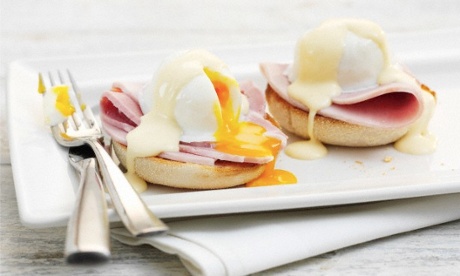Normally, seasonality is an agricultural fact. But for How to Eat (HTE) – the series identifying how best to enjoy Britain’s favourite foods – there is something unmistakably autumnal about the poached egg.
It is in October, as temperatures plummet, energy levels sag, noses run, boilers rattle and, on damp Wednesday nights, you find yourself incapable of cooking anything more substantial, that the poached egg comes into its own. It is hibernation food. Poorly food. Knackered food. Food that feels ever so slightly like giving up, which in that lack of ambition offers delicious liberation.
There are days when you want to stretch yourself in the kitchen and days when you make poached eggs. Days when, instead of artfully shooting your meals for multiple social media channels, you want to turn off your phone, retreat from the bewildering world outside and imagine yourself as a character in a lost Alan Bennett monologue (working-title: A Poached Egg for Richard Whiteley) or as the self-contained heroine in a particularly slow-moving Anita Brookner novel. A woman who, after a lifetime of quietly devastating disappointments, eats her poached egg with the flinty acceptance of someone who has learned to take modest pleasure in life’s margins. Let others dream of extravagant omelettes. You know where you are with poached eggs.
That reputation may explain the poached egg’s underperformance over lockdown. While the extraordinarily named press bureau the British Egg Information Service reports that scrambled, fried and boiled eggs all enjoyed a near 50% spike in consumption, poached eggs do not warrant a mention.
But as this week is British Egg Week, perhaps it is time to reconsider the role the poached egg plays in your life. For purists know that a poached egg need not be an act of miserable self-denial. True, only the monastic or masochistic would eat a poached egg au naturel. Unlike its eggy brethren, in order to truly shine, the poached egg demands a garnish, a dancing partner, some sort of titivating sauce or condiment. But that pairing opens up, if not a world, then certainly a bucolic village of possibilities, from baked beans to shaved Alba truffles.
Excited yet? HTE knew you would be. Let us proceed …
The egg
Food is shrouded in a lot of woo and guff. There are a lot of gullible people paying top dollar for handcrafted artisanal hype. However, the more you can afford to spend on eggs the better they generally are, and within price parameters that make it an affordable luxury. Freshness is vital, too. Older eggs tend to have watery whites (test: a truly fresh egg will sink in a glass of water and lie flat), so if you have a connect (a local market, farm shop, mate with hens) for the good stuff, tap them up.
Poaching technique
There are few upsides to Covid. But one glimmer of hope is that in the general societal reset/collapse, we will learn to regard chefs as eccentric food obsessives rather than secular gurus. Historians will analyse the early 00s and laugh mystified at our slavish devotion to celebrity chefs, much as we now pity our dimwitted ancestors for hanging on the every word of monarchs.
One thing those future historians will not be doing is wasting their time perfecting their vortex poaching, a cheffy technique that in high-skilled restaurant kitchens makes sense – we pay professionals for such perfection – but in a domestic setting is untenably convoluted and, due to the infrequency with which it is practiced, likely to result in a something closer to ectoplasm than food. You create the vortex, sieve your egg, add vinegar or salt, pat each egg dry with the attentiveness you would a newborn baby, and to what ugly, soggy, overcooked ends?
There are other methods, of course (off-heat and left to set, clingfilm etc), but even if you go beyond the vortex, such arcane detail as even the behaviour of the water is still crucial. As the food scientist Harold McGee notes in his mighty Food & Cooking, unless you slip your egg into tranquil, sub-boiling-point water at exactly the right moment to produce instant protein coagulation in the egg’s outer bloom, you will retrieve a terribly tousled, ragged egg. You can mitigate that with salt or vinegar, but too much will unattractively alter the egg’s texture. And on and on the process goes, life slipping inexorably through your fingers, while you attempt to trim a poached egg into something half-presentable.
Why don’t you just use a poaching pan, you ludicrous prima donnas? Yes, the buttered or oiled exterior takes on a slightly firmer quality – let’s call it an interesting textural variation – but with practice, vigilance (use a knife near the yolk to test doneness) and the right non-stick cups, it is possible to produce satisfactorily soft, yielding poached eggs from a poaching pan, while inducing pearl-clutching horror in a certain kind of foodie. Consider that bonus fun.
Serving
Classically, poached eggs are described as being served on toast. This is misleading. They should be served by toast, near toast, toast adjacent, but never on toast, where a mixture of steam or residual cooking water will create an unpleasantly damp ring on your slice.
That toast (never untoasted bread, you need that contrasting solidity and crunch) should be no more than 1cm thick – this is no place for hulking sourdough doorstops – and using the commercial bagged loaf as a standard unit of measurement, it should be served in a ratio of 0.75:1 toast to medium egg – so, 1½ slices for two medium eggs – or 1:1 for large eggs.
This ensures that, once you pierce the poached pouch, you have precisely enough toast to eat with the white and to mop up the yolk, in a way that moistens the toast without it turning into a sloppy mess and without leaving excess toast. No dipping in the yolk, please, this is not a boiled egg. The joy here is in releasing that lava-like flow and working quickly to contain it, to scoop it up and … my God, did you ever feel more alive?
HTE is sanguine about the bread choice. Except to say, brown-seeded breads bring a little extra flavour frisson to what can be a very bland dish, but anything darker than wholemeal can taste painfully worthy.
Toast is not the only platform. Texturally, crumpets turn woolly bathed in yolk, and potato cakes feel jarringly heavy. But a Birds Eye potato waffle or Simon Hopkinson’s fried slice bring a greasy edge of indulgence to proceedings that the poached egg conspicuously lacks.
Poached egg partners
Curiously, despite the components being the same, a poached egg and toast is less of a complete meal than a boiled egg and toast. The latter has active engagement in its favour (all that dipping and scooping), but also that the buttery toast plays as prominent a role as the boiled egg, in a way it cannot when trapped under a poached egg. Comparatively, the poached egg can feel flat and parsimonious, which may explain why it is so often used as part of a dish (see below), rather than as the star itself.
It is almost as if the meek, nervous poached egg needs a louder, giddier ingredient at its side to coax it out of its shell. To get the third round in. Crank up the music. That loosening-up is easily achieved given that a poached egg is a blank canvas for almost any condiment you care to throw at it or spread on the toast (Tommy K, Branston, caramelised onion chutney, drops of hot sauce, soy or fresh pesto). As she once told Russell Harty, after a hard day destroying people’s lives, Margaret Thatcher was given to poached eggs on Bovril toast, but please do not let that ruin yeast extracts for you. Avoid astringent sharpness (ie mustard, vinegars), but otherwise, as far as poached eggs are concerned, the world is your oyster sauce.
Similarly, a poached egg on toast comes alive in the presence of baked beans or spaghetti hoops. It perks up scattered with very finely diced fried chorizo or bacon. It achieves Zen contentment under a thick blanket of grated parmesan or very mature cheddar. The poached egg has an extraordinary affinity with smoked haddock, wilted spinach, smashed avocado and, particularly, wild mushrooms. There is something elementally good about earthy, meaty fried mushrooms bathed in rich yolk. As Ottolenghi dubs it: “Breakfast of champignons”.
Poached egg as ingredient
HTE does not have space to explore every occasion (eggs benedict, shakshuka etc), when the poached egg is used as a dish component. But a quick drive-by on a few golden rules is necessary. Self-dressing leafy salads topped with a poached egg (mmmm, cold, soon-slimy leaves covered in lukewarm yolk!) are almost universally terrible. Instead, the poached egg works best atop a dense mass of food that can hold and absorb its yolk: fish cake, rösti, hash.
Broadly, the same applies where poached eggs interact with what, for brevity, we will call “grains”. Texturally, there is something unpleasant – the grains turn gritty in your mouth or clump together stickily – where yolk is deployed in what should be a loose dish of rice, lentils or quinoa. An egg atop a tightly packed risotto of stubby arborio works OK. It amalgamates. But, for instance, long-grained and looser kedgeree is always better when mined with hard-boiled eggs. In 2016, British Egg Week was pushing the (donk-inspired?) hashtag #putaneggonit, but, please, proceed with caution.
When
Any time, literally. As easy to prepare at 4am as 4pm, and if sensibly sauced, guaranteed to hit that hungry spot with the minimum fuss.
Drink
The flat white is a naturally creamy fit with eggs, or opt for a mug of tea the colour of a disastrous fake-tanning accident. Save the booze for afters.
So, poached eggs, how do you eat yours?











